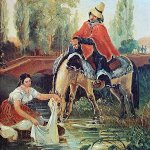National Huaso Day in Chile Date in the current year: September 17, 2025
 On September 17, on the eve of Independence Day, Chile celebrates National Huaso Day. This holiday is dedicated to Chilean horsemen, shepherds and farmers who are considered an important part of Chilean folk culture.
On September 17, on the eve of Independence Day, Chile celebrates National Huaso Day. This holiday is dedicated to Chilean horsemen, shepherds and farmers who are considered an important part of Chilean folk culture.The exact origin of the word huaso (plural huasos) is unknown. According to one theory, it is derived from the Quechuan word wakcha, meaning “orphan” or “outcast”, that is, a free and homeless person not belonging to any community, which is an important aspect of the huaso myth. Another theory claims that it is derived from the Quechuan word wasu, meaning either “rough and rustic” or “the back of an animal”. Initially, the term referred only to skilled “professional” horsemen, but lately began to also denote sheep raisers and farmers who rode on horseback while working.
The true origins of the word huaso are most likely untraceable, and its connection to the words wakcha and wasu is an example of the so-called folk etymology, when an unfamiliar word is attributed a certain meaning because it resembles a more familiar word. Interestingly, despite all the respect for huasos, the terms huaso and huasado are also used disparagingly to refer to crass and unsophisticated people, akin to the term “redneck” in American English.
Huasos are not a uniquely Chilean phenomenon; they have much in common with American cowboys, Mexican charros, Argentinian, Uruguayan and Brazilian gauchos, Peruvian morochucos, Colombian and Venezuelan llaneros, Hawaiian paniolos, Portuguese campinos, and Australian stockmen. The main difference between huasos and gauchos is that gauchos are primarily cattle herders, whereas huasos are also involved in farming. The majority of huasos live in Central and Southern Chile.
However, huasos are more than just horsemen, farmers and shepherds. They constitute an entire social group that is considered an important part of Chilean culture. No holiday or festival in Chile is complete without huasos in their traditional costumes, performing folk music and dancing folk dances. In addition, huasos are considered to be the embodiment of nobility, courage, devotion and patriotism.
The national dance of Chile that is traditionally performed by huasos is called cueca. When dancing, they usually wear a traditional costume consisting of a shirt, a short jacket, riding pants and boots with spurs, a chamanto (a traditional Chilean garment similar to a poncho), and a traditional straw hat named chupalla. Festive chamantos typically incorporate the national colors of Chile (red, white and blue).
As we’ve already mentioned, it is virtually impossible to imagine a Chilean holiday or festival without huasos. They always participate in the celebration of the so-called Fiestas Patrias – Independence Day (September 18) and Armed Forces Day (September 19) – so the preceding day, September 17, was even declared National Huaso Day to emphasize their importance for Chilean culture. It is marked with folk festivals held throughout the country, where huasos in their traditional costumes perform folk music, dance cueca and participate in Chilean rodeo.
- Category
- Cultural Observances
- Country
- Chile
- Tags
- National Huaso Day in Chile, holidays in Chile, cultural observances, huasos